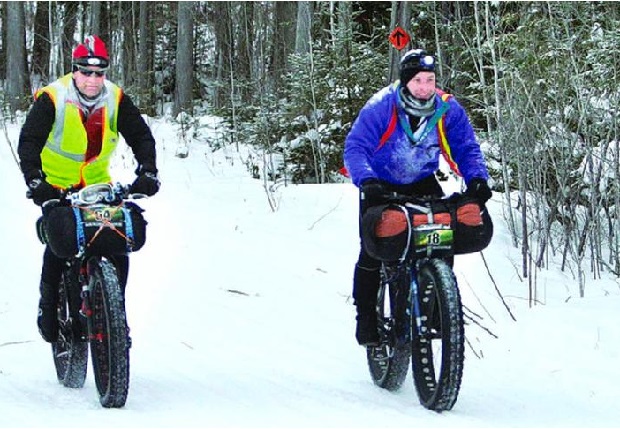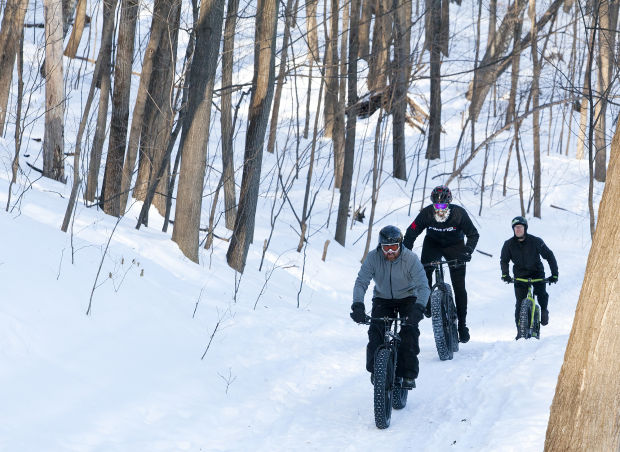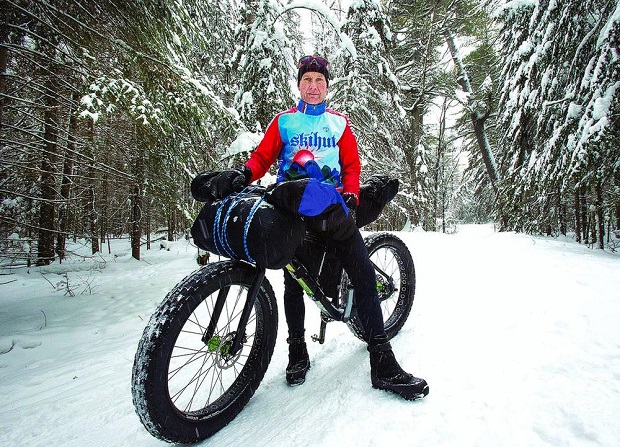Andy Rogers, Sun This Week/Dakota County Tribune
One hundred and thirty-five miles is a long drive, one many people wouldn’t consider if it was 40 degrees below zero. Even with milder temp’s for this morning start at 6 a.m. the select few will attempt to travel the 135 miles via a bike, cross-country skis or on foot through the backwoods of northern Minnesota.
The Arrowhead 135 is considered one of the most challenging endurance races in the world, one a few area residents know well. The race transverses across the Arrowhead State Snowmobile Trail from International Falls to Tower. Nearly every year it’s been minus 30 to minus 40 degrees at the start, however temperatures look to be much milder this year.
There are shelters and checkpoints along the way, but unlike other races where fans cheer you on, the Arrowhead 135 is a solitary venture. They come across more wolves than humans along the way. Last year’s winner, Jay Petervary, of Idaho, finished in 20 hours, 11 minutes. He was one of three individuals who finished in less than 25 hours.
Colorado’s Thomas Woods crossed the finish line more than two days after the race began and won the Shackleton Award, which goes to the person who spends the longest on the trail and finishes within the 60-hour limit.
“That’s the person who put the biggest effort into the race,” said Burnsville, Minnesota’s Dave Pramann, 57, who directed the race for three years with his wife Mary. “Think about being out there in 20 below for 60 hours. It’s usually someone on foot.” On average, less than 50 percent of the racers finish and its much less for rookies. Last year just 35 percent of racer’s made it to the finish line.
Pramann stepped down from directing the race last year, giving the two-time winner and former record holder a chance to race it again.
Not everyone tries to win — many just have a goal of finishing. Weather depending, Pramann’s goal is to finish before the bars close. Although Pramann underwent spinal fusion last summer, he doesn’t want to miss the chance at racing again.
“I’ve got enough experience, the worse conditions the better for me,” he said. “I can handle it.”
Participants are required to bring a sleeping bag, stove, water container and at least 3,000 calories among other survival items. A few participants set up camp for a few hours at night, while others power through.
Selecting food has become a science. Pramann carries two sticks of butter to make sure he’s legal and light. He carries macadamia nuts and fatty bacon in his pocket since they don’t freeze as easily. Cookie dough is a common treat as well, but the popular endurance fuels like energy gels and bars freeze solid, and keeping the water supply warm has become an art form.
They need to prepare for everything. Three years ago 12 inches of snow fell during the race.
“People went from biking pretty fast to dragging them,” Pramann said. To train, even when it’s several degrees below zero, Pramann straps on his bike helmet and heads for Lebanon Hills, in Eagan, Minn. or the Mississippi River Bottoms, south of the Mall of America. “If you can’t practice in the cold, it’s hard to know how to handle it,” Pramann said. “This year has been good for it. How someone from New Mexico or Florida trains for this, I’m not really sure.”
Often Pramann will leave his bike outside just to see what freezes first to know what replacement parts to bring. Burnsville’s, Dave Swanson, 43, will be attempting the race for a second time. Last year he dropped out after about 125 miles due to dehydration and frostbite.
“That wind brought the windchill down to negative 40,” Swanson said. “Once my eyeballs started to freeze over, I felt like it was time to quit. I figured it wasn’t worth losing a couple digits.”
He would like to finish this year, perhaps in the top 10. The biggest factor for him is clothing selection.
“Things that get cold the fastest are hands and feet,” Swanson said. “If you can solve that, it works pretty well.”
For Swanson, this is a training race – something to keep him active during the winter. Last year he was a member of the U.S. Mountain Bike Orienteering Team and participated in the Mountain Bike Orienteering World Championships in Poland and he plans on attempting the race again. Long-distance unguided races are his passion, and a 135-mile race will seem quick to Swanson in some respects.
In 2008 he participating in the Primal Quest in Montana, a nearly 600-mile, nine-day race where he navigated through the wilderness via bike and kayak with four others. He said you’d be surprised what the human body is capable of and he’s had a blast finding out. His experience helped him enter the Arrowhead 135, where participants don’t sign up for the race, they apply.
They only allow about 150 racers on the course who have previous ultra-distance experience in cold weather. So there is a good reason for the exclusivity: frostbite. Competitors have been hospitalized due to exposure, and there’s little support on the course.

Here at checkpoint 1, the Gateway Store, fat bikes wait as participants go inside to warm up and rest.
Prior Lake’s Ken Zylstra, 52, has competed six times in a row, finishing the last five, all via bike.
His experience with the Iditarod Trail Invitational, a 350-mile human-powered race in Alaska, and Leadville 100 in Colorado passed him through the application process.
His training includes long rides of up to nine hours mixed in with more intense five-hour rides. His regimen also includes yoga, weight training and a clean diet and that only gets you to the starting line. The right equipment will help prevent breakdowns, but to get to the finish is all in the mind. “It’s about how much you’re willing to suffer,” Zylstra said. “You experience every emotion possible out there. Concentrate on the things that are positive — the shimmer of the snow, the branches of the trees and just be happy you can feel your toes. You can’t concentrate on the fact your body hurts.
“Nothing is going to last long. If you feel really bad, or even if you feel really good, it’s not going to last forever.” Although he admits it’s not for everybody, he said just being there has shown Zylstra that a person can mentally and physically do anything. “It’s difficult to explain multiday racing and the pain and exhaustion you feel unless you actually do it,” Swanson said.
Those who drop out are often mentally defeated, not physically, he said. “They feel like they’re behind their pace, so they tend to stay a little longer at the check point and find it hard to get back out there,” Pramann said.
While the beginning is relatively flat, miles 60-110 are as hilly as Minnesota gets, where participants often walk. “I’ve been through some pretty brutal nights, and I didn’t see anyone,” Zylstra said. “You’re in charge of your own destiny.” But in the end, that’s what they’re chasing — the feeling of utter exhaustion and accomplishment. “To see the sunrise and the sun set and you’re still out there,” Zylstra said, “to see the stars and hear the wolves, the solitude and the camaraderie with those who are out there with you, it’s special. “Some of the best times I’ve had is at 3 a.m.,” Swanson said.
For more information and updates on race results during and after check out the Arrowhead 135’s Facebook Page.




